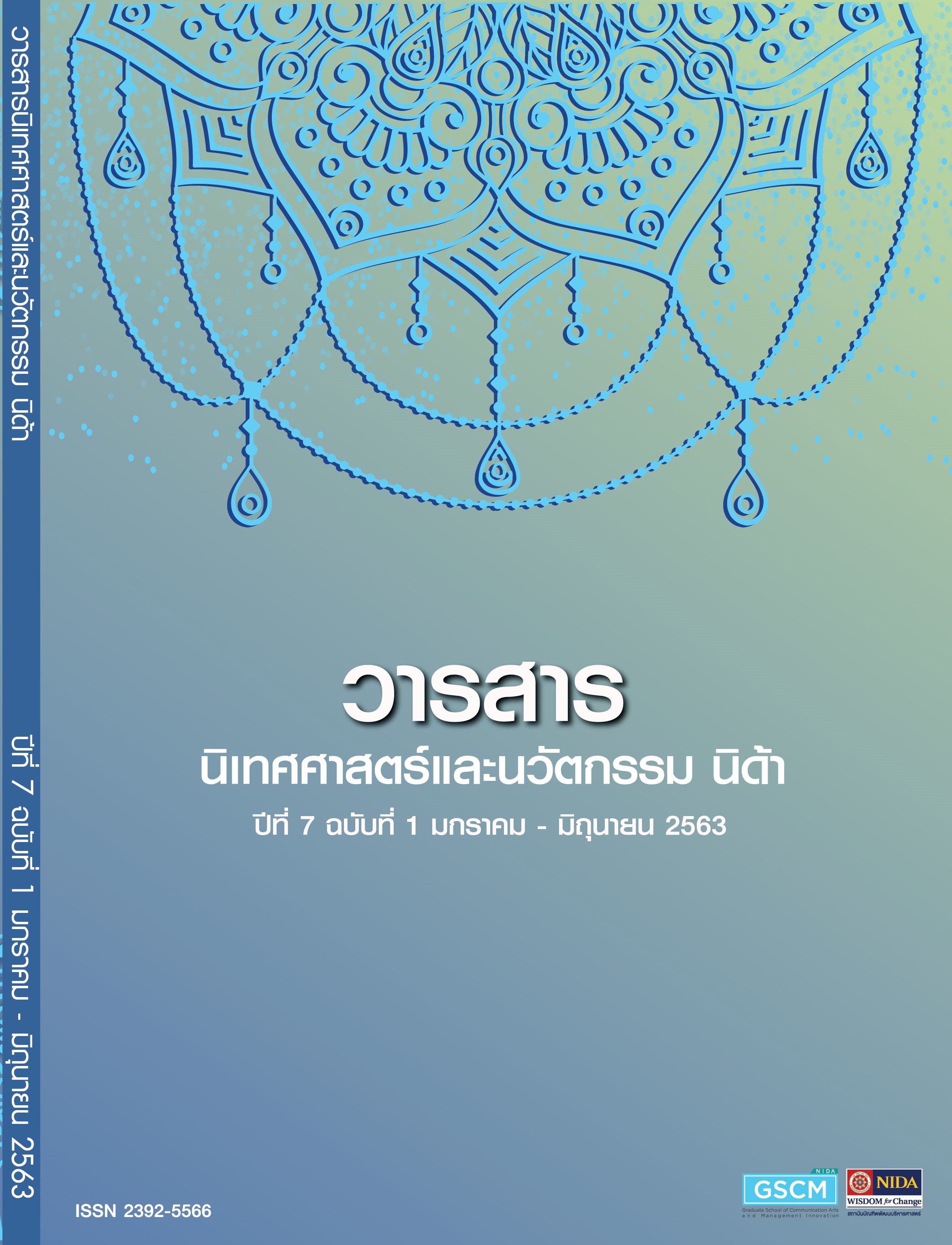การปรุงอำนาจผ่านความรื่นรมย์ในการทำอาหารของผู้หญิงในภาพยนตร์
Main Article Content
บทคัดย่อ
การศึกษาเรื่อง “การปรุงอำนาจผ่านความรื่นรมย์ในการทำอาหารของผู้หญิงในภาพยนตร์” (Women's Empowerment Through The Pleasure of Cooking in Films) เป็นการศึกษาในเชิงคุณภาพ (Qualitative Research) ด้วยวิธีการวิเคราะห์ตัวบทของภาพยนตร์ (Films texts) มีวัตถุประสงค์เพื่อศึกษา ‘สาร’ ผ่านกิจกรรมและความรื่นรมย์ที่เกี่ยวข้องกับอาหารที่ปรากฏในภาพยนตร์ ว่าในภาพยนตร์นั้นมีการถ่ายทอดมุมมอง และประกอบสร้างความเป็นจริงทางสังคมที่มีต่อการปรุงอาหารของผู้หญิงผ่านภาพยนตร์อย่างไร ผ่านการศึกษาและวิเคราะห์กระบวนการสื่อความหมายตัวบท รูปแบบเนื้อหา ของภาพยนตร์จำนวน 4 เรื่องได้แก่ Like Water for Chocolate (1992) Chocolat (2000) Waitress (2007) และ Julie & Julia (2009)
ผลการวิจัยพบว่าภาพยนตร์ทั้ง 4 เรื่อง มีการใช้ภาพและเสียงเพื่อสื่อความหมายโดยเน้นการสื่อสารอารมณ์รื่นรมย์ในการปรุงอาหาร โดยใช้ภาพที่มีลักษณะนุ่มนวลในฉากห้องครัวที่เป็นเหมือนพื้นที่ส่วนตัวของผู้หญิง และการใช้เสียงเพื่อสื่อความหมายทางอารมณ์ต่าง ๆ ของตัวละครเพศหญิงในระหว่างการปรุงอาหาร โดยมีจุดร่วมในการใช้การปรุงอาหารเป็นเครื่องมือในการแสดงออกทางอำนาจบางอย่าง เช่นปลดปล่อยความปรารถนาในจิตใต้สำนึก จินตนาการ อารมณ์ ความรู้สึก ที่ถูกกดอัด กักขังไว้ด้วยความแปลกแยกโดดเดี่ยวจากสังคมรอบตัว หรือใช้การทำครัวเป็นเครื่องมือทางอำนาจในการต่อสู้และต่อรองกับจารีตประเพณีที่เคร่งครัดและความคาดหวังของสังคม รวมถึงใช้การทำอาหารเพื่อสื่อถึงอำนาจผ่านความรื่นรมย์
Article Details
ข้อความและความเห็นในวารสารนิเทศศาสตร์และนวัตกรรม นิด้า เป็นของผู้เขียนแต่ละท่าน มิใช่ของคณะนิเทศศาสตร์และนวัตกรรมการจัดการ สถาบันบัณฑิตพัฒนบริหารศาสตร์
เอกสารอ้างอิง
กาญจนา แก้วเทพ. (2544). ศาสตร์แห่งสื่อและวัฒนธรรมศึกษา. กรุงเทพฯ: เอดิสันเพรสโปรดักส์.
กาญจนา แก้วเทพ และ สมสุข หินวิมาน. (2553). สายธารแห่งนักคิดทฤษฎีเศรษฐศาสตร์การเมืองกับสื่อสารศึกษา. กรุงเทพฯ : ภาพพิมพ์
กำจร หลุยยะพงศ์. (2554). “ดูหนังด้วยแว่นทฤษฎี”. วารสารวิทยาการจัดการ มหาวิทยาลัยราชภัฏเชียงใหม่, 6 (1), 21-50. สืบค้นจาก http://jms.crru.ac.th/datas/MJ_27_1_2554_87_ExJournal.pdf
คำ ผกา. (2559, สิงหาคม). “อนาจารในอาหารไทย”. มติชนสุดสัปดาห์. ปีที่ 36(1880), สืบค้นจาก https://www.matichonweekly.com/column/article_6145
ลักขณา คมคาย. (2540). การใช้อาหารเพื่อสื่อความหมายในภาพยนตร์คัดเฉพาะเรื่อง. (วิทยานิพนธ์ปริญญามหาบัณฑิต).จุฬาลงกรณ์มหาวิทยาลัย, กรุงเทพมหานคร.
สมสุข หินวิมาน. (2545). วัฒนธรรมชนชั้นกลางไทยในละครโทรทัศน์. รัฐศาสตร์สาร, 22(2),
สมสุข หินวิมาน. (2545). ครัว: พื้นที่การผลิตวัฒนธรรมแห่งชีวิตประจำวัน. รัฐศาสตร์สาร, 23(2),
สมสุข หินวิมาน. (2558). กินไข่ดาวสดๆ คาวๆ หอมๆ ฟุ้งๆ อย่าลืมบ้านทุ่งที่กินผักบุ้งแกงคั่ว : การสื่อสารอาหารข้ามชาติในกระแสโลกาภิวัฒน์. วารสารศาสตร์, 8(1),
อรุษยา ผู้พัฒน์. (2547). อาหาร : ความเข้าใจในเพศสภาพ ชนชั้น และอำนาจ. (วิทยานิพนธ์ปริญญา มหาบัณฑิต). มหาวิทยาลัยธรรมศาสตร์, กรุงเทพมหานคร.
de Certuau, Michel et al (1998), The practice of Everyday Life (Volume 2: Living & Cooking), Minneapolis : The University of Minneapolis Press.
Mannell, Stephen et al (1992), The Sociology of food : Eating, Diet and Culture, London : Sage.
Murcott, Anne (1983), The Sociology of Food and Eating: Essays on the Sociological Significance of Food, Hants : Gower.
Miriam Meyers, (2001), A Bite off Mama’s plate: Mothers’ and Daughters’ Connections through Food, Westport Conn : Bergin & Garvey.
Sherrie A. Inness, (2001) Kitchen Culture in America: Popular Representations of Food, Gender, and Race, Philadelphia : University of Pennsylvania Press.


